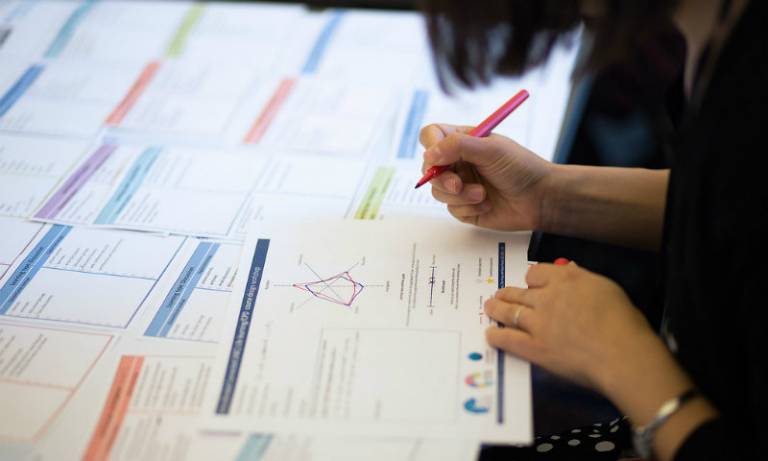Transforming a face-to-face course online
Dr Helen Barratt (UCL Department of Applied Health Research and NIHR North Thames CLAHRC Academy) shares her experience of taking a successful face-to-face course and transforming it fully online.

10 January 2017
"We have been running our popular face-to-face course for health care and public health staff, Introduction to Evaluation, since 2014. We decided to transform it into a fully online course as well, to make it more accessible to those who can’t readily travel to London to attend it.
I’d been involved in developing an online course before (with a colleague who received an e-learning development grant), and found the support provided by Digital Education very helpful. I therefore mapped out a rough plan and approached them to see what resources and support we could access, particularly as many of the team had limited experience of developing online learning.
The importance of planning and preparation
Natasa Perovic (Digital Education, SLMS) and Dr Mina Sotiriou (UCL Arena Centre for Research-based Education and UCL Life Learning) ran an ABC (Arena Blended Curriculum) workshop for us where we spent time planning the course. We storyboarded learning activities and, importantly, agreed a common language and terms so we all talked about things in a consistent way. This was an essential step in deciding what we wanted the learners to achieve. We then worked backwards to decide on the appropriate formats of delivery before we actually started creating anything.
The original plan had been to create a course that was entirely self-directed with no tutor involvement, but we realised through the planning process and the ABC workshop, that this wouldn’t be the best option. Instead, cohort-based learning with tutor engagement was needed to achieve the learning outcomes for our students.
The most important element, for me, was the planning involved in this project. I had a good idea from my own experience, and from interactions with Natasa and Mina, of how long the process would realistically take. It took at least two terms to get the course up and running. With time factored in for peer-review and user testing, it took close to a year from first approaching Digital Education to the course launch.
Using digital platforms and educational tools
The educational development process wasn’t that different to creating a face-to-face course, but online learning adds an additional layer of complexity. This was an existing course so we had all the materials. However, we had to think like online learners and adapt the teaching to that environment: looking at a presentation and dividing it up into 5 minute lecturecasts, for example.
Natasa recommended various software packages that we could use to create materials, but there was still a great deal of trial and error to find what worked for us. Factors such as tutors who had never worked online before and some that were non-native speakers meant that recording some materials took time and often several retakes. Tutors would put an incredible amount of effort into recordings that we’d have to redo because the sound or quality wasn’t good enough.
It’s essential that at least someone in your team is fluent with using Moodle. We were very fortunate to have an administrator in the team who quickly taught herself how to use Moodle and was then able to upload and format all the materials. Having to get to grips with the platform and then do this ourselves would have delayed us considerably.
Valuable skills for all involved
The time and effort invested in the course has been significant, but now we have a course that, with minor updates, can be reused many times. Our students now come from a much wider geographical area and are learning skills that would have been inaccessible to many of them otherwise.
We also have around 10 people in our department who now have experience of developing an online course. Having the experience and knowledge of the processes, support networks and an awareness of the time and resource effort needed is just as valuable and necessary as the new educational skills we have developed in online teaching.
Dr Mina Sotiriou commented:
"Creating an online course can be challenging at times but if planned carefully can be very rewarding for you and your students. Embrace the challenge and discuss your ideas with colleagues in Digital Education, CALT and Life Learning. Building an online learning culture is a collaborative process.”
Many of the issues or skills covered in this case study will be covered in events and workshops run by the Distance Education and Life Learning Forum. Subscribe to the mailing list to hear about these events.
Helen’s advice:
- Do some market research: make sure you know that this is something your target audience wants. This will be a big investment of time and resources, so make sure you’re doing the right thing.
- Plan everything in advance and allow time for essentials like approvals and testing. See an infographic by UCL Life Learning on development timings for short courses which might give you an idea of some essentials.
- Do an ABC workshop to help you plan out your learning activities. Contact Digital Education at digi-ed@ucl.ac.uk to discuss.
- Access and involve experts from Digital Education and UCL Arena Centre for Research-based Education from the very beginning to use their experience and expertise (when you need approval/peer review at the end, it will also be a big advantage if they have been involved from the start).
- Know (or learn quickly!) how to use Moodle.
 Close
Close

